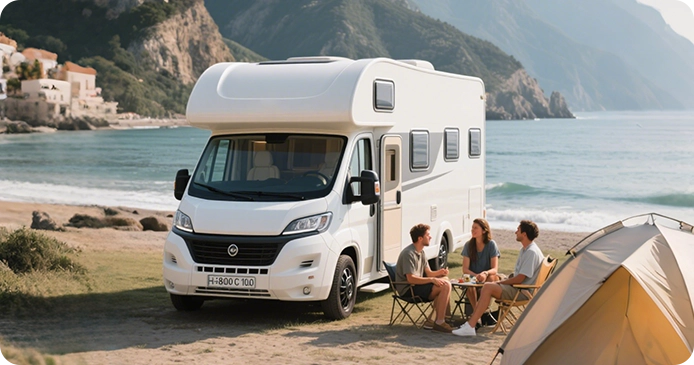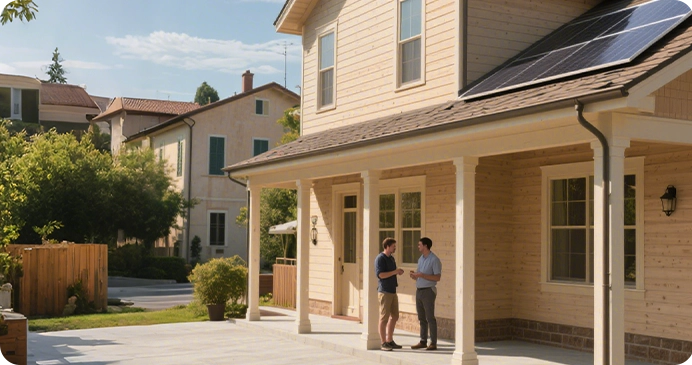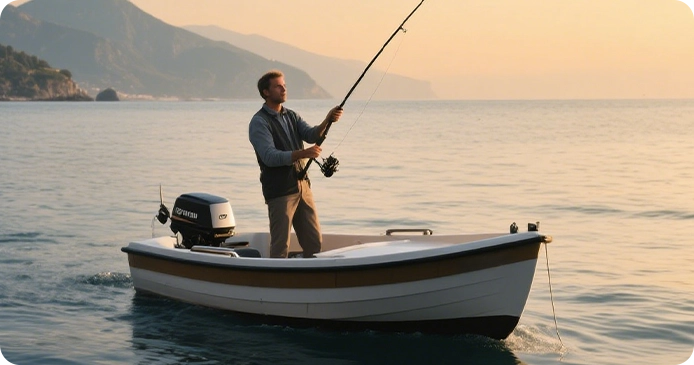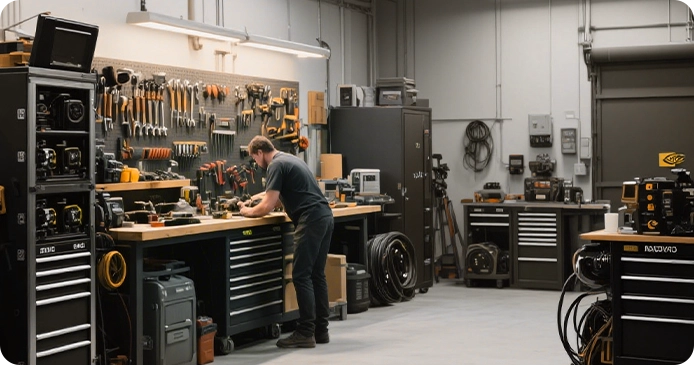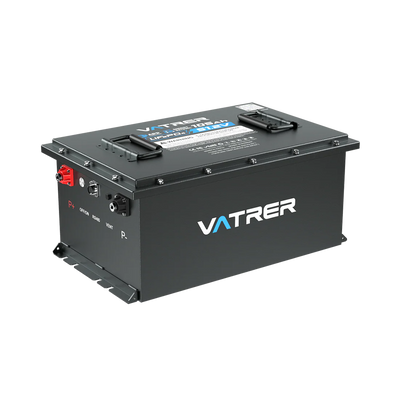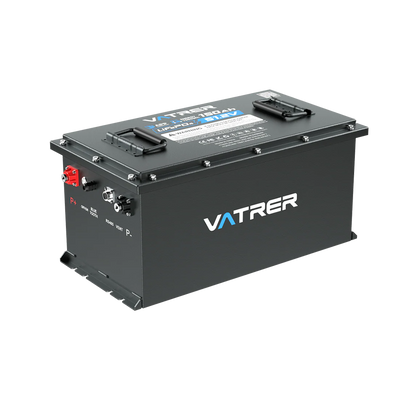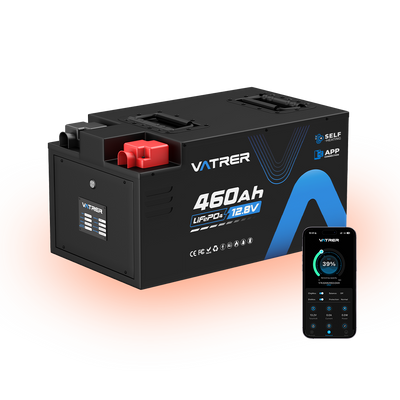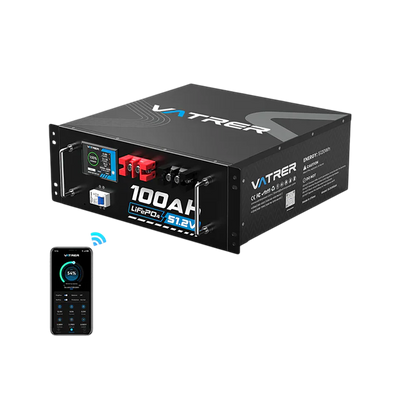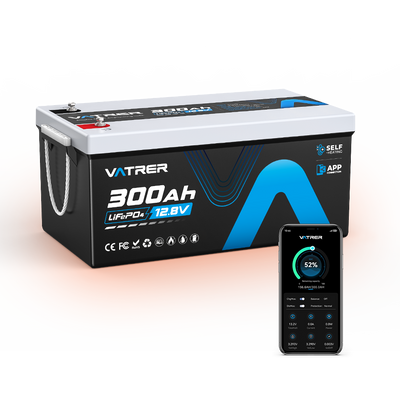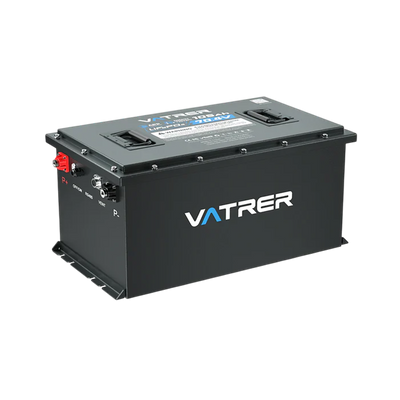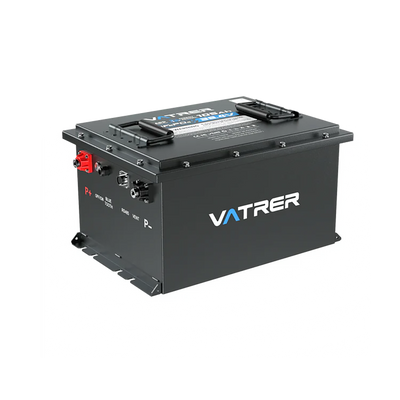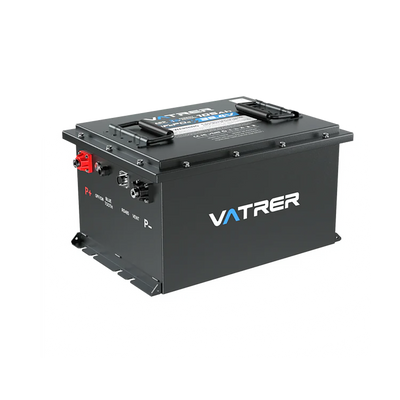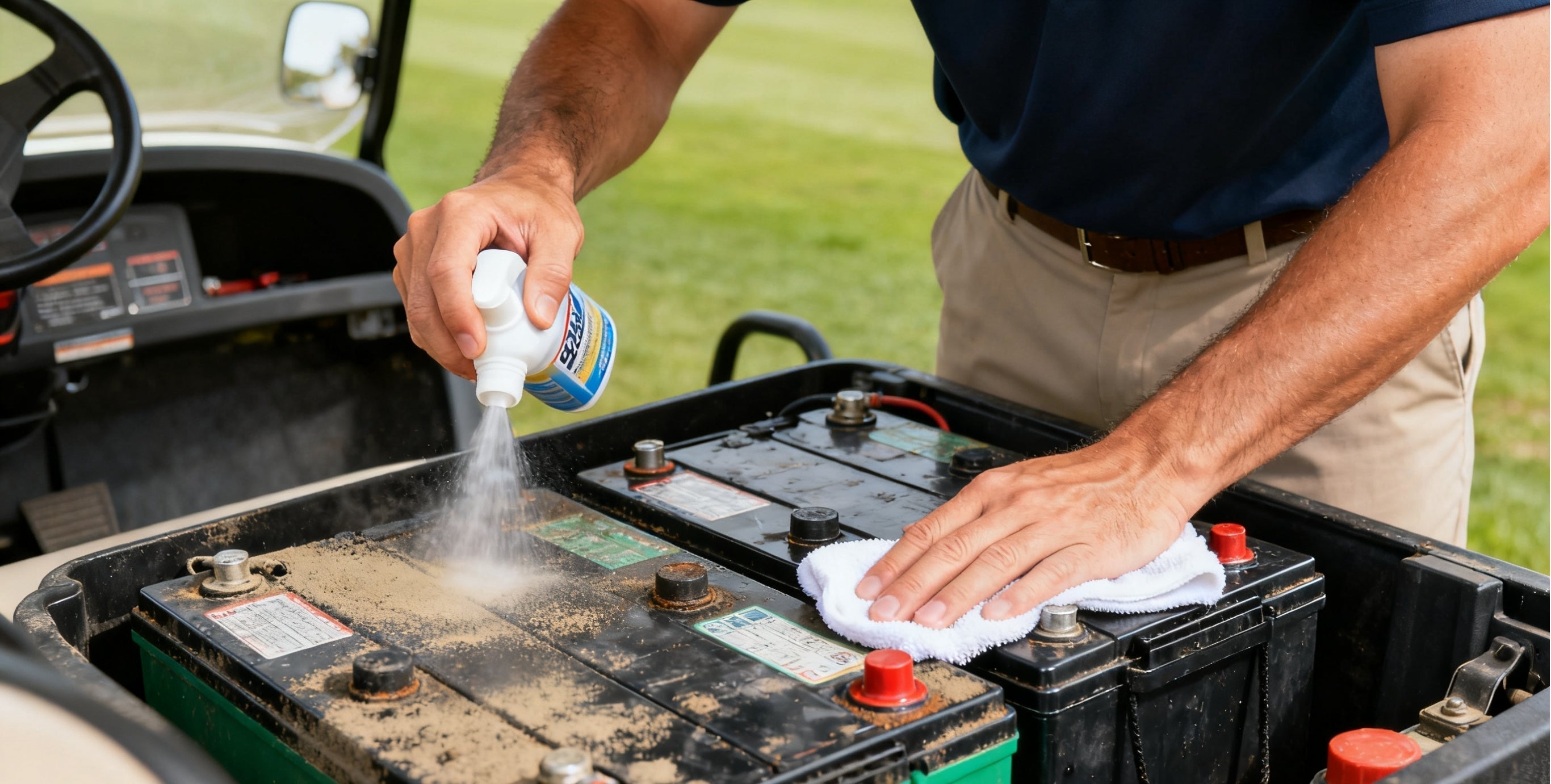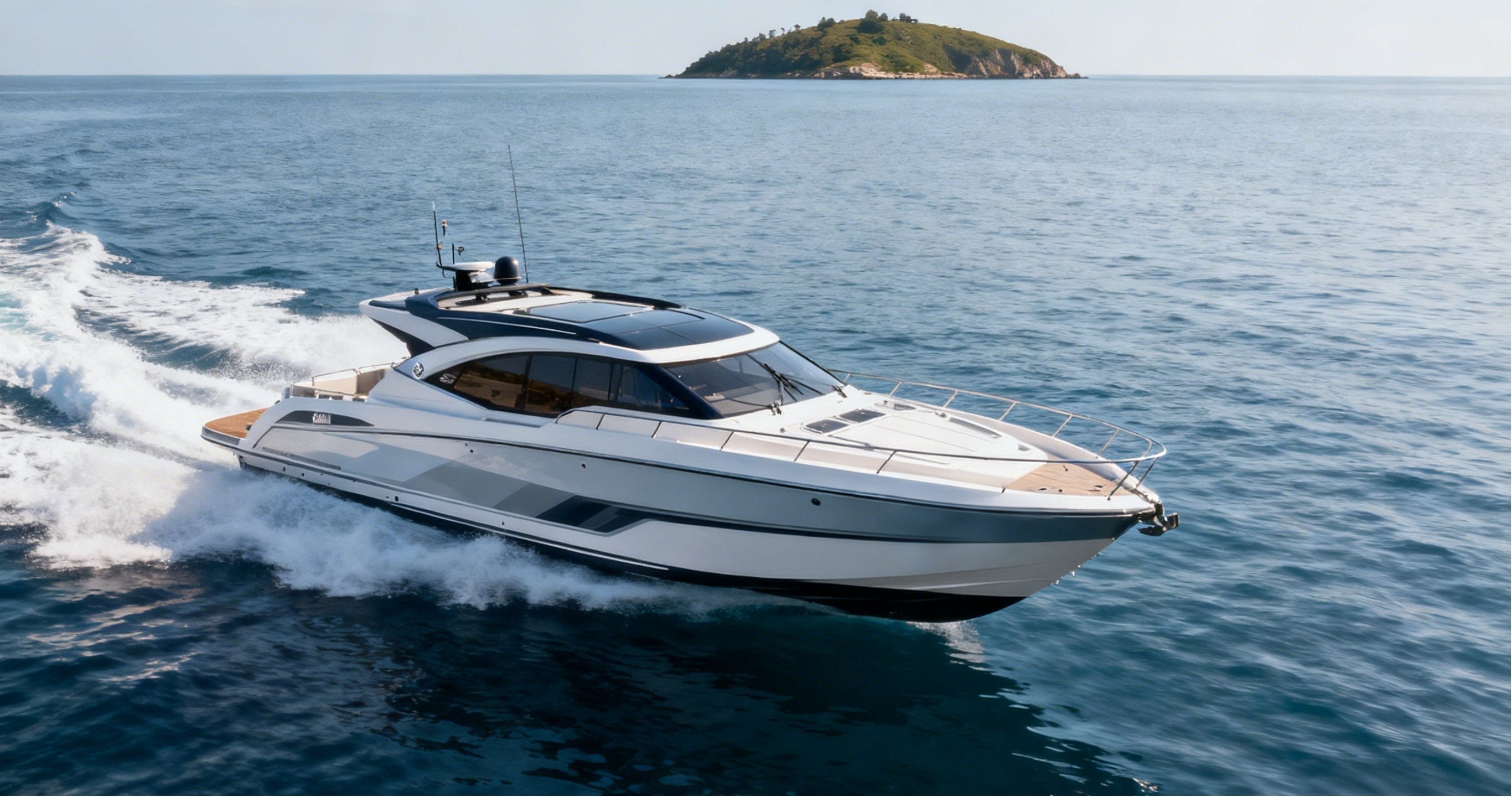
5 Best 12V Lithium Batteries for RVs
Imagine pulling into a remote campsite after a long day on the road, only to find your RV battery gasping, killing the lights, fridge, and that peaceful evening vibe. For RV owners chasing off-grid freedom, unreliable power is the buzzkill.
In this guide, we'll delve into why lithium batteries are ideal for RVs, compare them to other battery types, and recommend the five best 12V lithium batteries for RVs. Ready to power your adventures? Let's get started!

The Role of 12V Batteries in RVs and How They Work
Every RV runs on a 12V DC system at its core, it's the backbone that keeps your lights humming, water pump flowing, and fans spinning when you're off the grid. Without a dependable battery, even simple tasks like brewing morning coffee or running the thermostat grind to a halt, especially on those multi-day stretches without hookups.
So, how does a battery like this pull it off? At a basic level, it stores chemical energy and converts it to electrical current on demand. In lithium models, lithium iron phosphate (LiFePO4) cells move ions between positive and negative electrodes to release power smoothly. A built-in battery management system (BMS) acts as the brains, watching for issues like overcharge, deep discharge, or extreme temps to keep things safe and efficient.
For RV use, this setup means a typical daily draw of 50-200 amp-hours, from LED lights (5-10Ah) to a small inverter for AC gadgets (up to 100Ah)—gets handled without drama. Lithium batteries maintain steady voltage longer than alternatives, so your devices run cooler and more reliably. Think of it as swapping a finicky old engine for one that hums along and lets you travel smoothly all the way.
Comparing RV Battery Types: Lead-Acid vs. 12V Lithium Options
Not all RV batteries are created equal, and picking the right one boils down to your travel style, weekend warrior or full-time nomad? While lead-acid batteries have been the preferred choice for decades, lithium batteries have rapidly risen in recent years, with more than 70% of new RV configurations worldwide tending to use lithium batteries to ensure reliable off-grid power supply.
- Lead-acid comes in flooded (wet cell), AGM (absorbed glass mat), and gel varieties. They're affordable starters but come with trade-offs like heavier builds and shallower usable capacity.
- Lithium, especially LiFePO4, flips the script with deeper discharges and longer life.
To make it clearer, here's a quick side-by-side look at key differences. Help you understand the difference between the two in a more comprehensive and detailed way.
| Feature | Lead-Acid (Flooded/AGM/Gel) | 12V Lithium (LiFePO4) |
|---|---|---|
| Usable Capacity (% of rated Ah) | 30-80% (risks sulfation if deeper) | 80-100% (full draw without harm) |
| Weight per 100Ah | 60-80 lbs | 20-30 lbs |
| Cycle Life (to 80% capacity) | 300-800 cycles | 4,000-5,000+ cycles |
| Charge Time (full from 20%) | 8-12 hours | 2-5 hours |
| Self-Discharge Rate (per month) | 5-15% | 2-3% |
| Best For | Budget setups, shore power reliance | Boondocking, solar integration |
As you can see, if you're hauling gear across state lines or relying on panels for recharges, 12V lithium edges out for efficiency. Lead-acid holds its own for light-duty, plugged-in trips, but the gap widens over time. Lithium often pays for itself in 2-3 years through fewer replacements and fuel savings from lighter loads.
Why Switch to 12V Lithium Batteries for Your RV Power Needs
If you've ever nursed a fading lead-acid battery through a rainy weekend, you know the drill: constant monitoring, topped-off water levels, and that sinking feeling when voltage sags mid-recipe. Enter 12V lithium batteries, they're built for the realities of RV life, from dusty backroads to frosty mornings in Yellowstone. The benefits of upgrading lithium batteries are summarized below.
Longer Life That Actually Lasts
A typical 12V LiFePO4 battery delivers 4,000–5,000 full charge cycles, meaning 10+ years of daily use in an RV. Compare that to lead-acid batteries, which fade after 300–800 cycles (3–5 years max). Fewer replacements mean less hassle and lower long-term cost.
No Maintenance, No Fuss
Forget checking water levels, cleaning corrosion, or venting fumes. Lithium batteries are sealed, zero-maintenance units. Install them and you’re done, no seasonal upkeep is required.
Use 100% of the Capacity
Lead-acid batteries should only be discharged to 50% to avoid damage. Lithium lets you use nearly all rated capacity, a 100Ah lithium battery gives you 95-100% usable, while a 100Ah AGM gives just 50Ah. That’s double the real-world power in the same size.
Charge Faster, Travel Sooner
Lithium accepts charge rates up to 1C (full in 1–2 hours with the right charger). Lead-acid needs 8–12 hours. With solar or alternator charging, you’re back to full before lunch, not waiting all afternoon.
Drop Weight, Save Fuel
A 100Ah lithium battery weighs 20–30 lbs, the same capacity in AGM weighs 60–80 lbs. Cutting 100–300 lbs from your RV improves towing, handling, and fuel economy, real savings on every trip.
Built for Cold Weather
Most 12V lithium batteries include automatic self-heating, kicking in below 32°F to enable safe charging down to -4°F. No more frozen batteries or dead mornings in winter camping.
Seamless Solar & Inverter Compatibility
Lithium works natively with MPPT controllers and high-draw inverters, no voltage sag under load. Run your microwave, CPAP, or AC unit longer without the system choking.
Long-term Payback
While lithium batteries have a higher initial cost, they don't require regular watering and maintenance, their long cycle life means less frequent maintenance, and their lightweight design saves fuel, saving you hundreds of dollars annually.
So, if you camp for more than a few weekends a year, or rely on solar power, 12V lithium batteries aren't a luxury. They're a smarter, more reliable option for powering your RV life.
Choosing the Best 12V Lithium Battery for Your RV
Picking the right 12V lithium battery for your RV means matching power to your travel style, whether you're a weekend camper or a full-time boondocker. A pop-up trailer might hum along with 100Ah, while a Class A rig running AC and Starlink needs 400Ah or more. Here's how to nail the choice without guesswork.
Step 1: Calculate Your Daily Power Needs
Tally the amp-hours (Ah) your devices use daily. For example:
12V fridge (50W): 50W × 24h ÷ 12V = ~100Ah
LED lights (10W): 50W × 24h ÷ 12V = ~100Ah
Inverter losses (~10%): +10Ah
Total: ~114Ah/day. Add a 20% buffer for cloudy days or unexpected loads (~140 Ah recommended). Multiply by your off-grid days (e.g., 3 days = 420Ah).
You can quickly calculate it using the Vatrer online calculator.
Step 2: Match Battery to RV Type
- Small trailers/vans: 100-200Ah for basics (lights, pump, small inverter).
- Mid-size Class C/fifth-wheels: 300-460Ah for 2-3 days off-grid, including CPAP or microwave.
- Large Class A: 560-600Ah for heavy appliances (AC, Starlink) over a week.
Step 3: Check Key Features
- Inverter Compatibility: Need a 2,000W inverter. Choose a 200A+ BMS to avoid bottlenecks.
- Solar Pairing: Lithium loves MPPT controllers for fast charging, match panel wattage (e.g., 200W for 100Ah).
- Climate: For 32°F trips, pick heated models (auto-warm at -4°F) to charge safely.
- Scalability: Parallel 4-10 units for bigger RVs.
Tip: Undersizing leaves you stranded, oversizing adds weight. Test your setup with a 200W solar kit or 50A alternator to confirm recharge times.
5 Top 12V Lithium Batteries Best for RVs
Vatrer's best 5 12V lithium batteries excel in capacity, low-temperature performance, and app integration. All batteries utilize a LiFePO4 design for stability and are equipped with a battery management system (BMS) to prevent failure. Ultimately, you can choose the model that best suits your travel style and desired capacity.
Vatrer 12V 100Ah Heated
For RV owners dipping into boondocking, the Vatrer 100Ah battery provides a lightweight upgrade that extends power without overwhelming your setup. At just 24.2 lbs and Group 31 size (12.95 x 6.77 x 8.42 inches), it cuts about 50 lbs compared to lead-acid equivalents, easing fuel costs on highway hauls. The self-heating feature kicks in below 32°F to enable safe charging down to -4°F, preventing winter shutdowns during shoulder-season trips.
Key Advantages:
- 100A BMS supports up to 1280W surges for running lights, pumps, and small fans without drops.
- Bluetooth app tracks state-of-charge (SOC) and cycles in real-time, helping you plan recharges via 200W solar.
- Self-heating function stops discharging at temperatures below 32°F and resumes charging when heated to 41°F, ensuring you have peace of mind in all seasons.
- 5,000+ cycles at 100% depth-of-discharge (DOD) mean 10+ years of use with minimal fade.
Best For small trailers, pop-ups, or camper vans, best for 1-2 day getaways where you need 1280Wh to cover basics like a 40Ah fridge overnight.
Vatrer 12V 300Ah Heated
This Vatrer 300Ah model shines in mid-range RVs by delivering 3840Wh for multi-day autonomy, reducing generator runs and noise in quiet campsites. Weighing 55.23 lbs (15.16 x 7.56 x 9.76 inches), it saves space and 100+ lbs in battery banks, letting you pack more gear or tow uphill with less strain. The integrated heater activates heating when the current is above 10A, ensuring reliable start-up in temperatures as low as 14°F, which is ideal for areas with changeable climates.
Key Advantages:
- 200A BMS handles 2560W continuous output, powering microwaves or CPAP machines steadily.
- Fast 4-5 hour recharge with a 70A lithium charger or 850W solar array, minimizing downtime.
- IP65 dust/water resistance and even cell balancing extend life in dusty Southwest trails.
Best For Class C motorhomes or fifth-wheel trailers, suits families needing 2-3 days off-grid for essentials plus occasional 1500W inverter loads.
Vatrer 12V 460Ah Heated
Designed specifically for off-grid campers, the Vatrer 460Ah battery pack offers 5888Wh of capacity in a compact unit (18.78 x 10.75 x 9.92 inches, 104.7 lbs). It's equivalent to 5 100Ah batteries, but with simpler wiring and a cleaner interior. Replacing a lead-acid battery pack reduces the total weight of your RV by over 200 lbs, improving fuel efficiency on long trips. The automatic heating function activates at -32°F, ensuring uninterrupted charging in winter, crucial for northern routes.
Key Advantages:
- 300A BMS delivers 3840W peaks, supporting 2,000W+ inverters for tools or AC bursts.
- Bluetooth logs temperature and draw data, alerting you to imbalances during heavy use like 100A surges.
- Scalable to 4P4S configurations (up to 94.2kWh banks) for solar-heavy setups, with 5,000+ cycles.
Best For full-time fifth-wheels or toy haulers, handles extended dry camping with high daily draws up to 200Ah for appliances and tech.
Vatrer 12V 560Ah Heated
Designed for RV owners seeking extreme range, the Vatrer 560Ah battery boasts a massive 7168Wh capacity. Weighing 136.58 lbs, it can provide up to a week of power. Compared to multiple smaller batteries, the 560Ah battery is easier to install and requires less ventilation. Its low-temperature shutoff and self-heating features ensure safe discharge down to -4°F without requiring full heating (if temperatures drop too low, the heating automatically activates below 32°F). Furthermore, the companion app predicts runtime based on your load, making it ideal for planning routes without access to electrical outlets.
Key Advantages:
- 300A BMS maintains balance across 3,840W loads, running fridges and cooktops in parallel.
- 8-hour full charge via 1000W solar or 70A shore power, with <1% capacity loss after 4,000 DOD cycles.
- Expandable to 4S4P setups for massive banks, plus overheat/short-circuit safeguards.
Best For large Class A motorhomes, ideal for power users with 200+Ah daily needs, like Starlink and multiple inverters on multi-week tours.
Vatrer 12V 600Ah Battery
The Vatrer 600Ah battery, with a capacity of up to 7680Wh, is designed to meet the highest power demands of vehicle owners, providing ample power for heavy equipment even during extended power outages. It replaces bulky lead-acid battery packs, saving over 300 lbs of weight and cabinet space with just one battery. App-based settings and real-time monitoring prevent battery overheating in summer, and its rugged construction supports dual AC operation without voltage sag, extending your time in remote areas.
Key Advantages:
- 300A BMS powers 3840W outputs, handling EV chargers or dual appliances via large inverters.
- 5,000+ cycles with 70A genny recharges or 1920W solar fills, plus cycle tracking for maintenance.
- 4S4P parallel capability (up to 122.88kWh) for ultimate scalability in custom solar systems.
Best For power-heavy coaches or luxury Class A covers a full week off-grid with high loads like continuous 200Ah draws for HVAC and entertainment.
To give you a more intuitive and comprehensive understanding of these five best 12V lithium batteries, the following is a comparison table of key information to help you make your final choice:
| Model | Capacity (Wh) | BMS/Output (W) | Weight (lbs) | Charge Time (70A) | Best RV Fit |
|---|---|---|---|---|---|
| Vatrer 100Ah Heated | 1280 | 100A/1280 | 24.2 | 2-3 hrs | Small trailers/vans |
| Vatrer 300Ah Heated | 3840 | 200A/2560 | 55.23 | 4-5 hrs | Mid-size Class C |
| Vatrer 460Ah Heated | 5888 | 300A/3840 | 104.7 | 7-8 hrs | Full-time fifth-wheels |
| Vatrer 560Ah Heated | 7168 | 300A/3840 | 136.58 | 8 hrs | Large Class A |
| Vatrer 600Ah Battery | 7680 | 300A/3840 | 107.7 | 8-9 hrs | Power-heavy coaches |
Benefits of Choosing Vatrer 12V Lithium Batteries for RV
Vatrer 12V lithium batteries are designed with RV owners in mind, delivering practical advantages that keep you powered up on the road.
- Longer runtime, less weight: Each model uses high-density LiFePO4 cells to provide full usable capacity, cutting 60-70% off lead-acid weight for better fuel efficiency and easier towing.
- Cold-weather charging: Built-in self-heating (on most models) activates below 32°F, warming cells in minutes so you can charge safely down to -4°F, no more winter power lockouts.
- Bluetooth monitoring: The free app shows real-time SOC, voltage, temperature, and cycle count, letting you spot issues early and plan solar or alternator recharges.
- Fast, flexible charging: Full recharge in 2-10 hours (model-dependent) via 70A shore power, 1000W+ solar, or alternator, handles high input without damage.
- Scalable banks:Up to 16 batteries can be connected to create a large-capacity system, with cell balancing and monitoring from a single app, ideal for growing power needs.
- Road-ready durability:IP65/IP67 sealing shrugs off dust and splashes, a-grade cells and multi-layer BMS protect against overcharge, short-circuit, and vibration.
- Low total cost: 4,000-5,000 cycles (10-15 years) plus minimal maintenance mean fewer replacements and lower fuel/genny costs, payback often in 18-24 months.
- Hassle-free support: 5-year warranty (Learn more about Vatrer warranty policy), online chat, and free shipping via local warehouse make upgrades straightforward.
Conclusion
From fleeting blackouts to full-on freedom, the right 12V lithium battery transforms RV life—longer stays, lighter loads, and zero-fuss charging. Vatrer each brings steady voltage, deep cycles, and smart monitoring to match road warriors' needs.
If you're looking to go camping, lithium batteries are the perfect choice. Vatrer offers the perfect balance of durability, high-tech features, and affordability. Ready to upgrade your RV travel experience? Order now and enjoy a first-time user discount!
FAQs
How Do i Install a Vatrer 12V Lithium Battery In My RV?
Vatrer batteries are drop-in replacements for Group 24/31/8D lead-acid sizes—simply disconnect the old battery, clean terminals, and connect positive/negative cables to the new one (torque to 8-10 Nm). No fuse or relay changes needed for most rigs under 200A BMS. Enable Bluetooth pairing via the Vatrer app during first charge to verify balance. For parallel banks, use identical models and 2/0 AWG cables ≤3 ft long with equal length to avoid imbalance. Test with a multimeter (12.6-13.6V at rest) before closing the compartment.
Can i Charge Vatrer Lithium Batteries With My Existing RV Converter or Solar Controller?
Yes, but only if your converter has a LiFePO4 profile (14.2-14.6V bulk/absorb, no equalization). Most Progressive Dynamics, WFCO, or Victron units added after 2020 include this—check the manual. For solar, swap to an MPPT controller (Victron SmartSolar 100/30 or larger) set to LiFePO4, avoid PWM as it cuts efficiency 30%. Vatrer accepts up to 0.5C charge rate (e.g., 50A for 100Ah model) from alternator via a DC-DC charger like Renogy DCC50S to prevent vehicle battery drain.
How Many Solar Panels Do i Need To Fully Charge a Vatrer 300Ah Battery?
Target 5-6 peak sun hours (U.S. average). A 300Ah battery needs ~3840Wh daily. Divide by panel efficiency (80% real-world): 3840Wh ÷ 0.8 ÷ 5h = ~960W solar. Use 3× 320W panels (960W total) wired 3P to a 100/50 MPPT controller. Real-world is Arizona owners recharge in 4 hours, cloudy Midwest may need 6-7 hours or generator top-off.
Is It Safe To Run My RV Air Conditioner On a Vatrer Lithium Battery Bank?
Yes, with proper sizing. A 13,500 BTU AC draws ~1300W running (1800W startup surge). Pair two Vatrer 300Ah (600Ah total) with a 3000W inverter/charger. Runtime: ~4-5 hours at 50% DOD. Add 800W solar to extend to all day. Use soft-start kits (Micro-Air EasyStart) to cut surge 60%. BMS handles 200A continuous—no overheating reported in 100°F tests.
How Do i Store My Vatrer 12V Battery During Winter?
Charge to 50-60% SOC (app shows exact %), disconnect all loads, and store at 32-60°F (garage ideal). Self-discharge is <3% monthly. Check voltage every 3 months via app or multimeter—top off to 13.2V if below 12.6V. Avoid freezing, the heater won’t activate without charge current.
Can i Mix Vatrer Batteries With Other Lithium Brands In The Same Bank?
Not recommended. Different BMS algorithms cause imbalance—Vatrer’s active balancing only syncs with identical models. Stick to same capacity/age for parallel (up to 4P) or series (up to 4S).
Share






































































